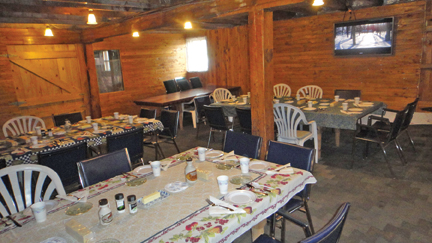Apple picking within everyone’s reach
A unique non-profit organization called Kéroul has dedicated itself to promoting tourism for people with physical disabilities within the province of Québec. Accessibility is a key issue for the disabled and elderly, and Kéroul offers more than 200 tourism experiences that meet its standards, forming what is called The Accessible Road.
Kéroul has trained 1400 people in the hospitality and tourism industry in the principles of accessibility through its program Welcoming Ways.

photo by Kéroul
To be part of the Accessible Road, establishments must meet these criteria:
- Staff trained in the Welcoming Ways program to guarantee quality service
- Full access to the site
- An entrance free of any obstacles.
- Doors with at least 76 centimetres of width clearance for a wheelchair
- Corridors free of obstacles and with at least 92 centimetres of clearance for turning in a wheelchair
- Public restrooms, bedrooms, and bathrooms with at least 1.5 m X 1.5 m of manoeuvring
- Outdoor paths of a least one meter width
- Grab bars for toilets, showers, and bathtubs
- At least 68.5 centimetres of clearance beneath washbasins.
A sample outing: Le Beau Markon
For instance, if you’re planning an outing, why not go to the île d’Orléans, the cradle of French America? To discover the local specialties, take advantage of fully accessible activities at the farm Le Beau Markon, located in Sainte-Famille. This agritourism farm offers apple picking and many enjoyable farm activities. A significant portion of its clientele comes from long-term care centres. Even if you are 100 years old, this outing is for you.

photo by P. Markon
Owners Dominique Le Beau and Philippe Markon are accreditated by Kéroul as providers of Welcoming Ways. They welcome you with a smile and accept only one group at a time, reserving a section of the orchard for each group. This means that each group can easily pick apples from low-hanging branches. Dominique and Philippe ensure that the orchard is free of obstacles, including fruit that has fallen to the ground. They take care to have easy-to-navigate slopes, grass, and trails.
Once you have picked and tagged your bag of apples, they go in a cart and are delivered to your bus, leaving you unencumbered as you explore the orchard. And there is no need to rush your outing for lack of a fully accessible washroom. All this is taken care of. The rustic beauty of the site becomes the perfect backdrop for a picnic. You can have a close look at the farm animals and discover all that happens on the farm.
Fun even on a rainy day
Groups love coming to Le Beau Markon, even when it’s not very nice outside. The staff pick several varieties of apples in the morning and display them in the reception room, where you can take your pick. In the barn, you’ll listen to a presentation (supported with photos) about the life of the farm over a one-year period, including the orchard in flowers, the sugar shack, and the production of apple juice and maple syrup.
Under the large sloping roof adjacent to the barn, the horse and the dog will greet and entertain you. After that, it’s fresh apple juice tasting and a draw for different products of the farm.
So much to take away
Not only will you be able to pick your own basket of apples, but you will learn all about the different varieties and their features. And while you’re there, why not add to your basket a bottle of the farm’s delicious fresh apple cider, some pears grown in the orchard, a few maple products, or a container of their home-made sauerkraut?
A memorable day at the orchard in l’île d’Orléans is just one example of the many accessible outings that Kéroul promotes. In 2011, the organization won the Ulysses Award for Innovation in Non-governmental Organizations from the United Nations World Tourism Organization.
Lyne Ménar, Assistant Director at Kéroul.
https://www.keroul.qc.ca/en/home.html
Click Here for print PDF file – Active living – apple picking within everyone’s reach
What Active Living Is All About
Put very simply; it is a way of life.
- It is about maintaining a balance in your life of the physical, mental, emotional, social, and spiritual.
- It is about choosing activities that you enjoy, and including them in your daily routine.
- It is about staying connected with friends.
- Your mental health is as important as your physical health.
- It is about making good food choices.
By maintaining good health, it is about having the ability to make choices in your life, and live as independently as you choose. Active living makes you feel good, and prevents many chronic diseases.
So why not give it a try? You have nothing to lose, and so much to gain.
How much is enough?
How much physical activity do you need to gain health benefits? Here is the latest research:
- 150 minutes a week of moderately intense activity (for instance 30 minutes a day, 5 days a week).
- Activity can be broken down into bouts of 10 minutes like a walk around the block.
- Start slowly and build up. For instance, just start by doing more of what you are already doing.
- Walk whenever you can. Brisk walking is a perfect ‘moderate intensity’ physical activity. Walking can be done anywhere, anytime, anyplace, without any special equipment.
- How fast is “brisk”? That depends on you. On average, it means walking 3 – 4 miles (4.8 – 6.4 km) an hour, or about the speed you would walk if you were late for an appointment. It should not be so fast that you are unable to talk.
If you want to start an exercise program that is more demanding than brisk walking, talk to your health care provider first.

Question: “Active Living” claims more benefits than the legendary Snake Oil Salesman’s Magic Elixir does.
TRUE or FALSE?
Answer: TRUE! – There are so many benefits to active living that at first glance, even the con artist might be skeptical. Nonetheless, active living does reduce the risks of all of the following:
- Heart attack and heart disease
- Falls, fractures & injuries
- Obesity and being overweight
- High blood pressure
- Osteoporosis
- Diabetes (post-menopausal women)
- Stroke
- Anxiety and depression
- Gallstones
- Colon Cancer
- Arthritis
- Enlarged prostrate
- High cholesterol
- Premature death
- And much, much more.
Remember: inactivity is the primary lifestyle risk in old age.
(With thanks to the Saskatchewan Seniors Mechanism)
Click Here for print PDF file – Active Living – What active living is all about

- Categories
Recent Posts

